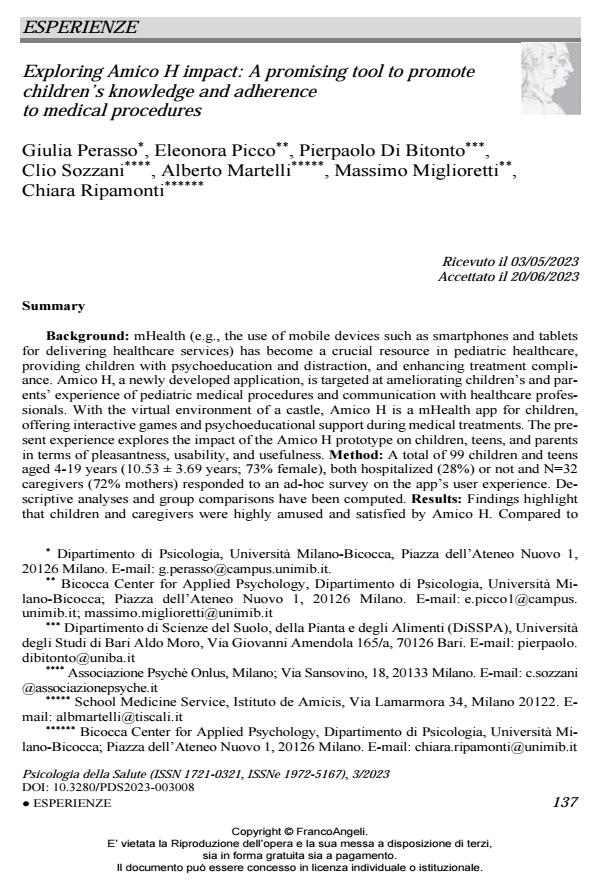Exploring Amico H impact: A promising tool to promote children’s knowledge and adherence to medical procedures
Titolo Rivista PSICOLOGIA DELLA SALUTE
Autori/Curatori Giulia Perasso, Eleonora Picco, Pierpaolo Di Bitonto, Clio Sozzani, Alberto Martelli, Massimo Miglioretti, Chiara Ripamonti
Anno di pubblicazione 2023 Fascicolo 2023/3
Lingua Inglese Numero pagine 17 P. 137-153 Dimensione file 362 KB
DOI 10.3280/PDS2023-003008
Il DOI è il codice a barre della proprietà intellettuale: per saperne di più
clicca qui
Qui sotto puoi vedere in anteprima la prima pagina di questo articolo.
Se questo articolo ti interessa, lo puoi acquistare (e scaricare in formato pdf) seguendo le facili indicazioni per acquistare il download credit. Acquista Download Credits per scaricare questo Articolo in formato PDF

FrancoAngeli è membro della Publishers International Linking Association, Inc (PILA)associazione indipendente e non profit per facilitare (attraverso i servizi tecnologici implementati da CrossRef.org) l’accesso degli studiosi ai contenuti digitali nelle pubblicazioni professionali e scientifiche
mHealth (e.g., the use of mobile devices such as smartphones and tablets for delivering healthcare services) has become a crucial resource in pediatric healthcare, providing children with psychoeducation and distraction, and enhancing treatment compliance. Amico H, a newly developed application, is targeted at ameliorating children’s and parents’ experience of pediat-ric medical procedures and communication with healthcare professionals. With the virtual en-vironment of a castle, Amico H is a mHealth app for children, offering interactive games and psychoeducational support during medical treatments. The present experience explores the im-pact of the Amico H prototype on children, teens, and parents in terms of pleasantness, usabil-ity, and usefulness. Method: A total of 99 children and teens aged 4-19 years (10.53 ± 3.69 years; 73% female), both hospitalized (28%) or not and N=32 caregivers (72% mothers) re-sponded to an ad-hoc survey on the app’s user experience. Descriptive analyses and group comparisons have been computed. Results: Findings highlight that children and caregivers were highly amused and satisfied by Amico H. Compared to teens, children needed more help from adults in the use of the app. Conclusion: All the results indicate that Amico H is a pow-erful tool to ameliorate pediatric hospitalization experience and to promote children’s knowledge about health and medical procedures. The need for age-specific versions of Amico H emerged. Future directions and limits are discussed.
La mHealth (e.g., l’uso di dispositivi mobili come smartphone e tablet per fornire servizi sanitari) è diventata una risorsa cruciale in campo pediatrico, poiché può fornire ai bambini psicoeducazione e distrazione, e può migliorarne l’aderenza al trattamento. Amico H, un’applicazione mHealth appena sviluppata, è mirata a migliorare l’esperienza dei bambini e dei genitori rispetto ai trattamenti medici in campo pediatrico e fortificare la comunicazione con i professionisti sanitari. Tramite l’ambiente virtuale di un castello, Amico H offre giochi inte-rattivi e supporto psicoeducativo durante il trattamento medico. Lo scopo della presente espe-rienza è esplorare l’impatto del prototipo di Amico H sui bambini, sugli adolescenti e sui geni-tori in termini di piacevolezza, usabilità e utilità. Un totale di 99 bambini e adolescenti di età compresa tra 4 e 19 anni (10.53 ± 3.69 anni; il 73% femmine), sia ospedalizzati (28%) che non, e N = 32 caregiver (72% madri) hanno risposto a un sondaggio ad hoc sull’esperienza dell’utente della app. Sono state effettuate analisi descrittive e confronti di gruppo. Dai risultati emerge che i bambini e i caregiver sono divertiti e soddisfatti di Amico H. Rispetto agli adole-scenti, i bambini hanno avuto bisogno di maggiore aiuto dagli adulti nell’utilizzo della app. Complessivamente, i risultati indicano che Amico H può essere un potente strumento per mi-gliorare l’esperienza di ospedalizzazione pediatrica e promuovere la conoscenza dei bambini sulla salute e sulle procedure mediche. È emersa la necessità di versioni di Amico H specifiche per età. Sono discusse, inoltre, le prospettive future e i limiti dello studio.
Parole chiave:bambini, genitori, ospedale, mHealth, comunicazione, salute, pediatria, tablet.
- Fostering the psychological wellbeing of children diagnosed with cancer: multidisciplinary insights in pediatric oncology Giulia Perasso, Marco Romeo, Paola Coccia, Giulia Palego, Palina Perez-Duarte Mendiola, in Frontiers in Psychology 1495969/2025
DOI: 10.3389/fpsyg.2025.1495969
Giulia Perasso, Eleonora Picco, Pierpaolo Di Bitonto, Clio Sozzani, Alberto Martelli, Massimo Miglioretti, Chiara Ripamonti, Exploring Amico H impact: A promising tool to promote children’s knowledge and adherence to medical procedures in "PSICOLOGIA DELLA SALUTE" 3/2023, pp 137-153, DOI: 10.3280/PDS2023-003008